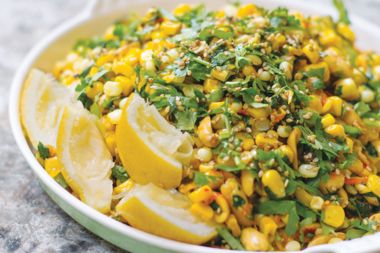
Flying into Delhi in the middle of the night is disorienting. We arrived at our hotel only after weaving through freeways, on-ramps and off-ramps, and darkened tree-lined side streets, eventually resting our heads after 2 am.
The morning brought masala dosa and lassi for breakfast, and we decided to dive into Old Delhi’s chaotic Chandni Chowk straight away—a sea of people, rickshaws, and sidewalk rubble, and an assault of signage. We sought out feathery layered and stuffed parathas for lunch at a stall where you sit on a bench facing the narrow, ancient alleyways before you.
And after, we made our way to the spice market, where I saw a cluster of women in electric green and pink saris crouched in a strip of dirt between spice vendors. They were sorting pistachios—nut from shell. One was eating a simple bowl of rice topped with a smear of what looked like an Indian harissa paste and edged by a peanut-corn vegetable medley of sorts. It was beautiful and simple and you knew at a glance it tasted good. Here’s my version. You can enjoy it over rice, over lentils, or on its own as a side dish.
Tip
This recipe is best with fresh corn—although you can use frozen corn that has thawed. Even better, swap in chopped asparagus, broccoli, or another vegetable when corn isn’t in season.
Vaghareli Makai
Ingredients
- 2 small fresh red chili peppers, stemmed
- 2 medium cloves garlic
- 1 in (2.5 cm) piece of ginger
- 1/4 tsp (1 mL) turmeric
- 1/4 tsp (4 mL) fine-grain sea salt
- 2 Tbsp (30 mL) clarified butter (ghee) or sunflower oil
- 1 1/2 tsp (7 mL) yellow or brown mustard seeds
- 1 lb (450 g) fresh corn kernels
- 1/2 cup (2 oz/55 g) roasted peanuts
- 1 cup (1 oz/30 g) chopped cilantro
- 1 or 2 lemons, cut into wedges and seeded
- 2 Tbsp (30 mL) toasted sesame seeds
Nutrition
Per serving:
- calories310
- protein10g
- fat19g
- saturated fat6g
- trans fat0g
- carbohydrates33g
- sugars10g
- fibre6g
- sodium178mg
Directions
01
Use a mortar and pestle or food processor to smash the chili peppers, garlic, ginger, turmeric, and salt into a paste.
02
In skillet over medium-high, heat butter. Add mustard seeds, and once they have begun to pop, stir in corn. Cook, stirring gently but constantly for a minute or so; then add peanuts, half the cilantro, and half the prepared chili paste. Cook for another minute or so; taste, and add the rest of the paste if you donu2019t find the dish too spicy, and a good squeeze or two of lemon juice. Taste and adjust the seasoning if needed.
03
Serve topped with the remaining cilantro, sesame seeds, and remaining lemon wedges.




